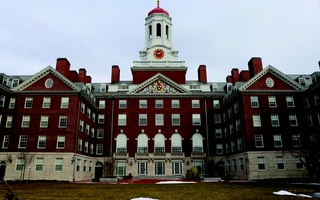Data and science are king—or president, rather—in Carlos E. Díaz Rosillo’s class on American presidential elections, Government 1359: “The Road to the White House.”
The course, which is offered every four years to coincide with presidential elections, has seen record enrollment this semester. With more than 514 students enrolled as of Thursday night, the Road to the White House is the second largest course at the College this semester.
Gov 1359 is not your typical government course. While the class has a syllabus, its curriculum closely follows the events of each presidential election, which now in 2016 is heating up as the field narrows. As a result, no two iterations of the course are exactly alike.
“It was really cool because we studied what a primary is, what a caucus is, exactly a week after the first-in-the-nation Iowa caucus, and exactly a day before the first-in-the-nation New Hampshire primary,” Díaz Rosillo, a Government lecturer and resident dean of Dunster House, said.
But the course does not merely cover the ins and outs of the campaign news cycle; rather, it is a rigorous application of scientific theory to the reality of the current election, Díaz Rosillo said.
“The class is not a political class; it’s a political science class,” he said. “What we try to do in class is study cutting edge political science theory on campaigns and elections, and then we use the current campaigns as a lab in which students can explore whether the theories they’re learning in class actually apply to real life campaigns.”
Recently, students studied the different models by which political scientists predict election outcomes, along with the advantages and shortcomings of each of the systems. Students saw the limitations of how polling played out in Iowa, where early projections did not accurately predict results.
The course’s emphasis on data analysis stems in part from Díaz Rosillo’s background as a civil engineer. Trained at Tufts University, Díaz Rosillo says he sees political science as a kind of engineering, in which one can use data to explain political trends.
“I like to understand processes and how things work, and why they work the way they do,” Díaz Rosillo said. “Even though the two fields, engineering and social science, seem so different, they’re really not because they’re both about using data to analyze things; they’re about using data to make decisions.”
Decision-making quickly became the focus of Díaz Rosillo’s work when he chose to study public policy at the Harvard Kennedy School. In addition to teaching the Road to the White House, Díaz Rosillo also researches and teaches about executive power at all levels of government. Government 94fg: “Presidents, Governors, and Mayors: Chief Executive Power in Comparative Perspective” was offered in the fall.
Díaz Rosillo’s current research emphasizes the use of data to inform presidential campaigns at the local and precinct levels, a project he hopes will soon yield positive results and “help somebody run a better and more effective campaign.”
In the meantime, students en masse are enrolling in the Road to the White House, although the course counts only as an elective, even for Government concentrators.
“I’m pretty confident that people are taking the class not because they can check off a box but because they’re really interested in the material,” Díaz Rosillo said.
Miranda L. Ryshawy ’18, who described herself as someone who generally does not follow elections closely, said that a desire to understand this year’s election on a more scientific level, along with encouragement from her roommate, prompted her interest in the class.
“This is the first election I’m going to be able to vote in,” she said. “I think I will definitely look back on it as my baptism into being an active citizen.”
Edgar A. Carrero ’19 has also enjoyed the course.
“It’s interesting to analyze a bit deeper than what you read about online,” he said.
As the election season progresses, students will continue to apply their skills of analysis in real time. Applying his own analytical skills, Díaz Rosillo offered predictions for the Republican and Democratic nominees. Based on current data, he said he was confident the Democratic nomination would go to former Secretary of State Hillary R. Clinton. The Republican nominee, however, is not as clear cut.
“I think based on the data and based on what we know right now, I’d say it’s going to be Donald Trump or Marco Rubio,” Díaz Rosillo said.
–Crimson staff writer Jonathan G. Adler can be reached at jonathan.adler@thecrimson.com. Follow him on Twitter @JonathanGAdler.Read more in College News
Peer Counseling Groups Wrap Up Training For New CounselorsRecommended Articles
-
 Cheating and Regret at Forefront of Díaz’s Latest
Cheating and Regret at Forefront of Díaz’s Latest -
 A Brief Wondrous Talk with Junot Díaz
A Brief Wondrous Talk with Junot Díaz -
I Ain’t Your TeacherR: Feed me a diverse curriculum, please. Z: I can’t describe the unimaginable feeling of validation that would come from seeing the narrative of our community gracing the pages of syllabi and being discussed in section.
-
Students Say Trump Adviser Díaz Rosillo Not Partisan in ClassStudents say lecturer Carlos E. Díaz Rosillo, who teaches the popular class Government 1359: “The Road to the White House,” has largely hidden his political leanings during his classes.
-
 College Hires Resident Deans for Winthrop, Eliot, and Dunster Houses
College Hires Resident Deans for Winthrop, Eliot, and Dunster Houses













